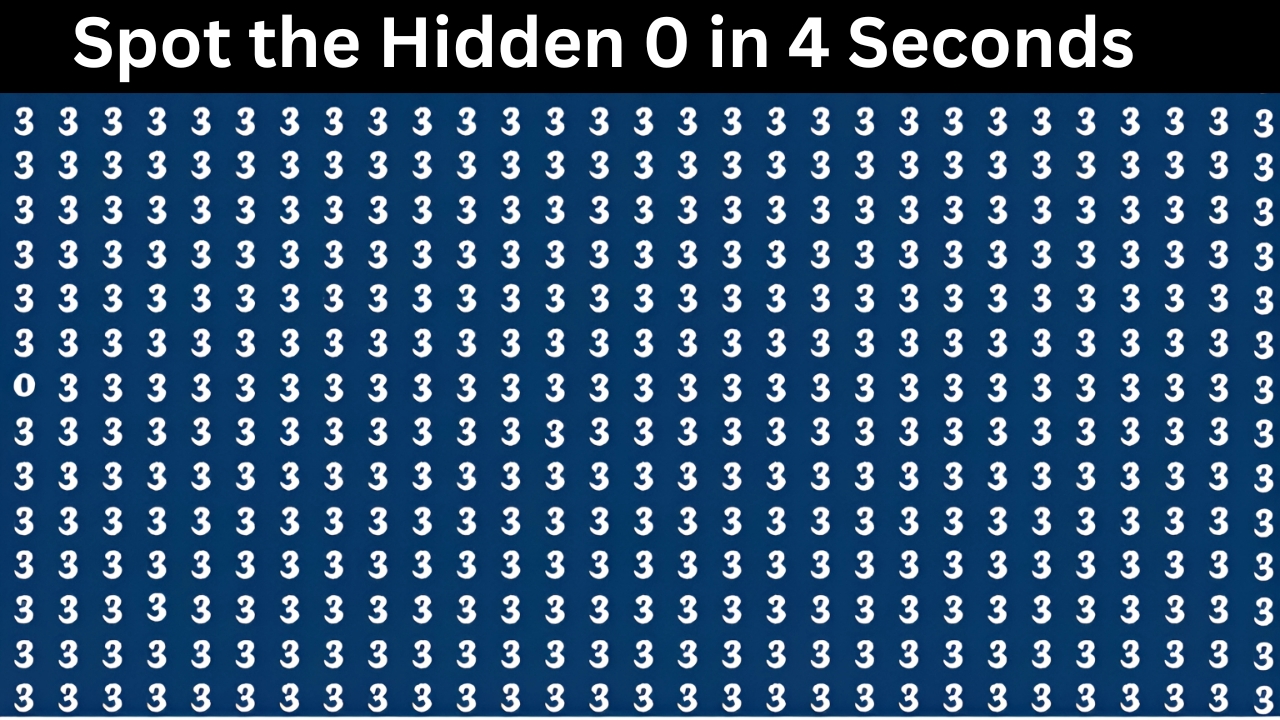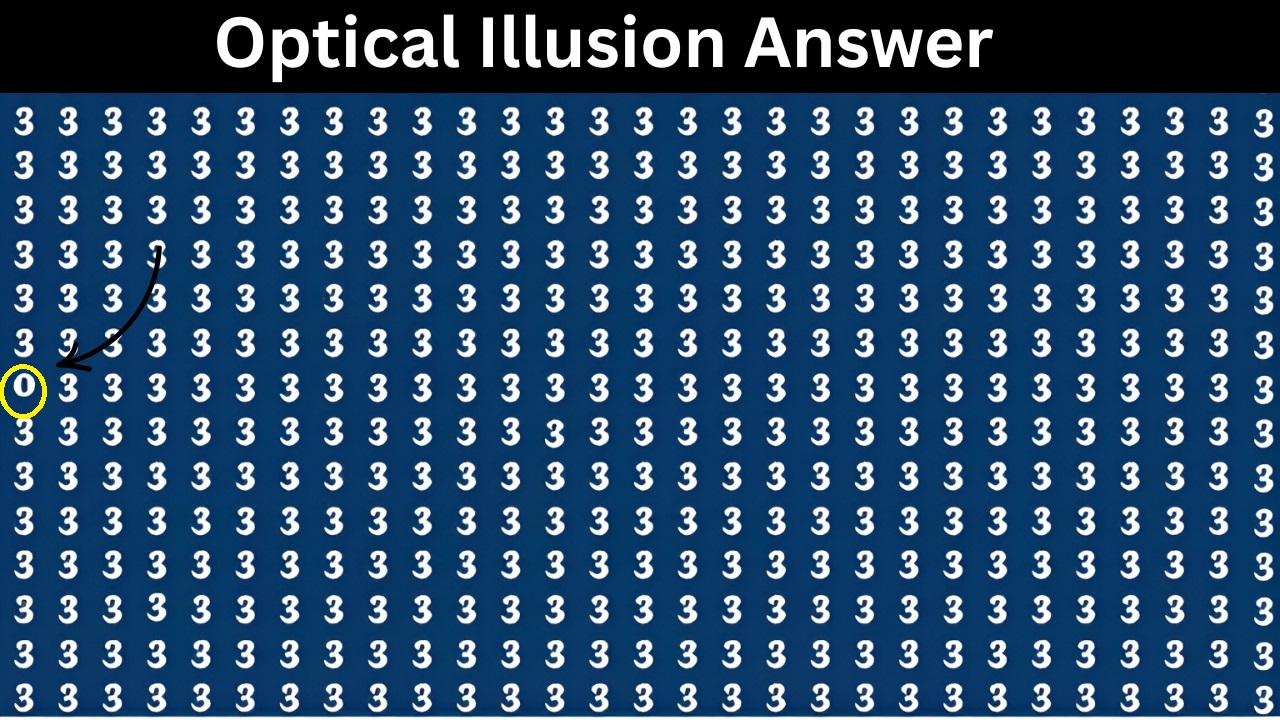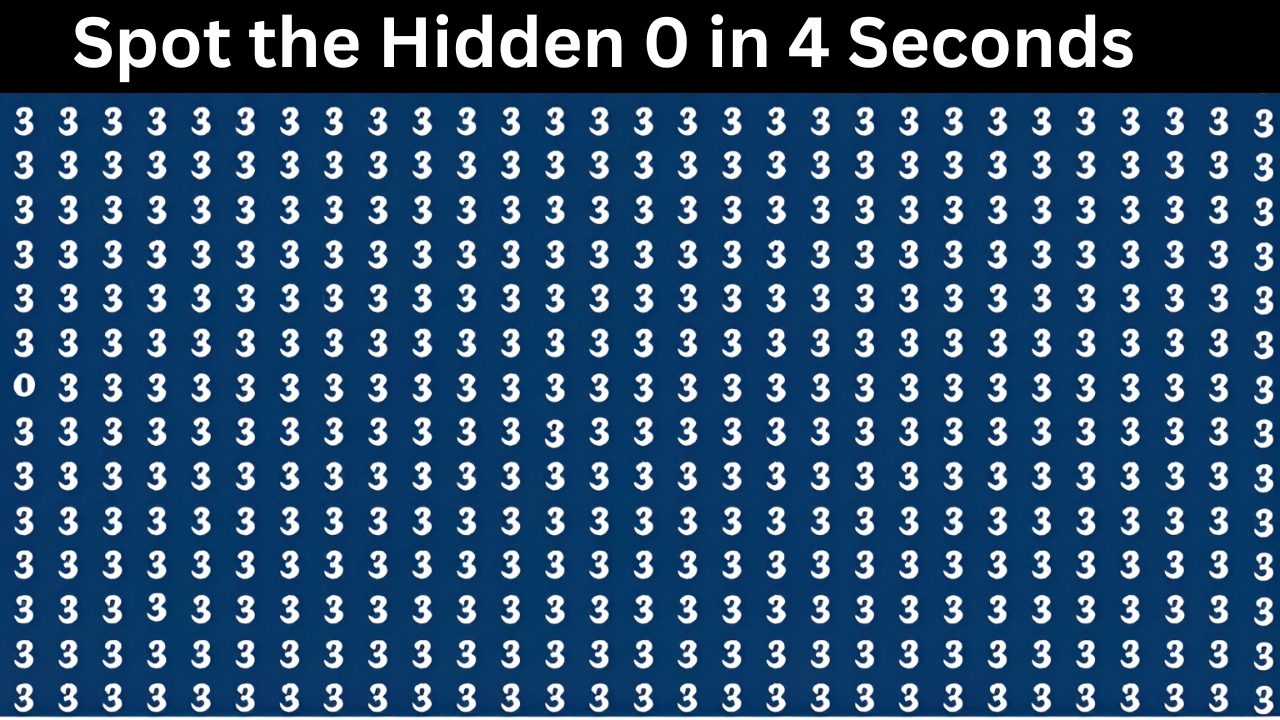Hidden 0 : Optical illusions are fascinating visual puzzles that challenge our perception and test our cognitive abilities. They captivate people of all ages by creating a delightful interplay between what our eyes see and what our brains interpret. One such engaging optical illusion is the challenge to “Spot the Hidden 0 in 4 Seconds.”
This brain teaser not only entertains but also sharpens our observation skills, making it a perfect exercise for anyone looking to boost their mental agility. In this article, we’ll explore the allure of optical illusions, the specifics of this particular challenge, tips to solve it, and why such activities are beneficial for our brains. Let’s dive into the mesmerizing world of visual trickery!
The Magic of Optical Illusions
Optical illusions are images or patterns that deceive our visual perception, making us see things that may not align with reality. They exploit the brain’s tendency to make assumptions about shapes, colors, and patterns based on past experiences. This creates a mismatch between what we expect to see and what is actually present. Optical illusions are not just fun; they are a window into how our brains process visual information, revealing the complexities of human perception.

The “Spot the Hidden 0 in 4 Seconds” challenge is a classic example of a hidden object illusion. In this type, a specific element—in this case, the number 0—is camouflaged within a busy or patterned image. The goal is to locate it within a tight time frame, adding an element of urgency that heightens the excitement. These illusions are popular because they combine visual intrigue with a competitive edge, making them irresistible to puzzle enthusiasts.
Understanding the Challenge
Imagine a grid or image filled with numbers, letters, or symbols, where a single 0 is cleverly disguised. The task is to find this hidden 0 in just 4 seconds. The short time limit makes it a high-pressure challenge, as you must quickly scan the image while avoiding distractions from similar-looking elements, such as the letter “O” or other numbers like 8 or 6, which can easily be mistaken for a 0.
The image might feature a dense arrangement of digits in various fonts, sizes, or colors, creating a visual overload that tests your focus. Alternatively, it could be a pattern where the 0 blends into the background, using color gradients or shading to mask its presence. The difficulty lies in overcoming the brain’s tendency to gloss over details when faced with a complex scene, especially under time pressure.
Why Are Optical Illusions So Engaging?
Optical illusions like this one captivate us for several reasons. First, they tap into our natural curiosity. The challenge of finding something hidden sparks a sense of adventure, like solving a mystery. Second, the time constraint adds a layer of thrill, pushing us to rely on quick thinking and sharp observation. Finally, the satisfaction of spotting the hidden 0 provides a rewarding dopamine boost, making the experience addictive.
These illusions also serve as a mental workout. They engage multiple cognitive processes, including visual processing, attention, and pattern recognition. By challenging our perception, they encourage us to think outside the box and question our assumptions, fostering creative problem-solving skills.
Tips to Spot the Hidden 0 in 4 Seconds
To succeed in this optical illusion challenge, you need a strategy that maximizes your efficiency within the limited time frame. Here are some practical tips to help you spot the hidden 0:
-
Scan Systematically: Instead of letting your eyes wander randomly, adopt a structured approach. Scan the image from left to right or top to bottom, like reading a book. This ensures you cover the entire area without missing spots.
-
Focus on Contrasts: The hidden 0 might stand out due to slight differences in color, shading, or size. Look for anomalies in the pattern, such as a number that appears slightly bolder or lighter than its surroundings.
-
Avoid Distractions: Similar-looking characters like “O,” 8, or 6 can trick your brain. Train yourself to differentiate the 0 by noting its distinct shape—a perfect oval with no breaks or extensions, unlike the letter “O,” which may have subtle variations in certain fonts.
-
Use Peripheral Vision: Sometimes, staring directly at the image can cause you to miss the hidden element. Let your eyes relax and use your peripheral vision to detect subtle differences in the pattern.
-
Practice Quick Focus: The 4-second time limit requires rapid concentration. Before starting, take a deep breath to calm your mind and sharpen your focus. This helps you avoid panic and stay attentive.
-
Look for Negative Space: In some illusions, the 0 might be formed by the spaces between other elements rather than being a solid shape. Check for outlines or gaps that could form the number.
By practicing these techniques, you can train your brain to spot the hidden 0 more quickly and accurately, even under pressure.
The Science Behind Optical Illusions
Optical illusions work by exploiting the brain’s visual processing system. Our eyes capture light and send raw data to the brain, which then interprets it based on patterns, context, and prior knowledge. However, this interpretation isn’t always accurate. Illusions like the hidden 0 challenge take advantage of phenomena like figure-ground organization, where the brain struggles to distinguish the foreground (the 0) from the background (the surrounding pattern).
The time limit adds another layer of complexity. Under pressure, the brain relies on heuristics—mental shortcuts—to process information quickly. These shortcuts can lead to errors, such as mistaking an “O” for a 0 or overlooking the hidden number entirely. By engaging with these illusions, we can better understand how our brains prioritize certain visual cues over others.
Benefits of Solving Optical Illusions
Engaging in optical illusion challenges offers more than just entertainment. Here are some key benefits:
-
Improved Observation Skills: Regularly solving hidden object puzzles enhances your ability to notice fine details, which can be useful in everyday tasks like reading maps or spotting errors in work.
-
Enhanced Focus and Concentration: The time constraint forces you to block out distractions and hone your attention, improving your ability to stay focused under pressure.
-
Cognitive Flexibility: Optical illusions encourage you to shift perspectives and think creatively, which can boost problem-solving skills in other areas of life.
-
Stress Relief: While the 4-second limit adds excitement, solving these puzzles can also be a fun way to relax and take a mental break from daily stressors.
-
Brain Health: Activities that challenge perception and cognition help keep the brain sharp, potentially delaying age-related cognitive decline.
Variations of the Challenge
The “Spot the Hidden 0 in 4 Seconds” illusion is just one of many similar puzzles. Variations might involve finding other numbers, letters, or shapes within a cluttered image. Some versions increase the difficulty by using monochromatic patterns, where the 0 blends seamlessly into the background, or by incorporating motion, where the image shifts slightly to disorient the viewer.
You can also create your own version of this challenge by designing a grid of numbers and hiding a 0 within it. Use a mix of fonts, sizes, and colors to make it trickier, and test your friends or family to see who can spot it fastest. This DIY approach adds a creative twist and lets you customize the difficulty level.
How to Practice and Improve
To get better at spotting the hidden 0, practice is key. Start with simpler optical illusions to build your confidence, then gradually tackle more complex ones. Online platforms and mobile apps offer a variety of hidden object puzzles that you can try daily. Set a timer to simulate the 4-second limit and track your progress over time.
Another way to improve is by engaging in other brain-training activities, such as memory games, pattern recognition exercises, or even mindfulness practices that enhance focus. The more you train your brain to process visual information quickly, the better you’ll perform in time-sensitive challenges like this one.
Optical Illusion Answer

The “Spot the Hidden 0 in 4 Seconds” optical illusion is a delightful blend of fun, challenge, and cognitive exercise. It tests your ability to see beyond the obvious, sharpens your observation skills, and provides a satisfying sense of accomplishment when you succeed.
By understanding the science behind optical illusions and applying strategic tips, you can improve your performance and enjoy the thrill of uncovering hidden elements in a flash. So, the next time you encounter this brain teaser, take a deep breath, focus your eyes, and dive into the challenge. Can you spot the 0 in just 4 seconds?

